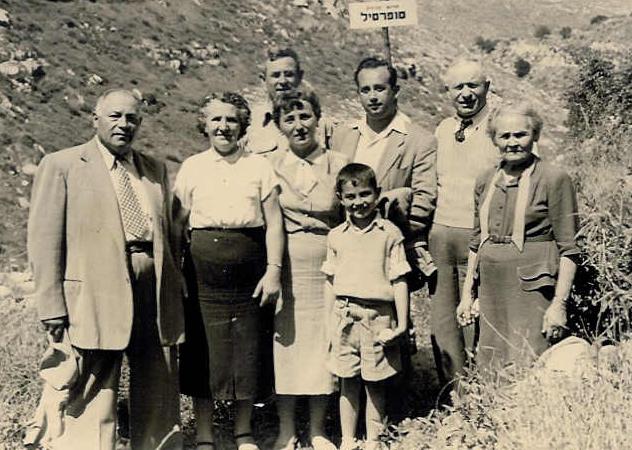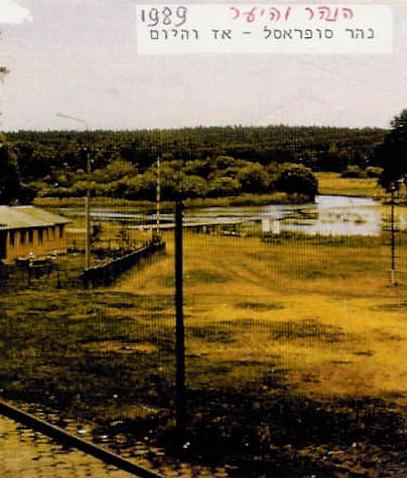We Remember Jewish
Suprasl!
|
Yaacov
Patt z"l It is with great sorrow that I
inform you about the death of Yaacov Patt z"l on Heshvan 23, 5764 ( Yaacov Patt had
an exceptional personality. He immediately gave permission to post the
book in JewishGen, understanding the importance of the Internet media
although he belonged to another generation. |
|
|
|
|
|
|
|
LIFE
AND DEATH
IN SHADOW OF THE
The Story of Suprasl -
A
Shtetl in
By Yaacov Patt
Published with the assistance of "Amos Fund"
Jack and Genia Liberman.
(c) All Rights reserved by the Author Printed in
Dedicated with love to:
Haya, Boaz and Hanna, Galit, Maor and Vered, Batia and Avi, Orli-Zehava and
Corey-Pinchas
...For
man is a tree of the field... its branches grow according to its roots...
The
Author

Dedication ceremony of the
From Right to left: Mrs. Gotlieb, Gdaliah Gotlieb, Jakob Pat, Boaz Pat, Rajzel
Smiaticki, Mrs. And Szmerl Kaplan
CONTENTS
Life and Death in Shadow of the Forest .......................................... 3
A Town on the Way to the Forest......................................................... 9
About the Author................................................................................ 13
On the Banks of the Suprasl River ................................................ 15
The Birth of a Jewish Community........................................................ 17
The Jewish Community between the Two World Wars........................ 20
Industrial and Economic Development................................................. 22
The Bitter End of the Cytron Family.................................................... 24
The Cytrons - The Story of a Jewish Dynasty............................... 26
The War Years................................................................................. 33
Suprasl during the Holocaust............................................................... 42
Treblinka - Suprasl Jewry's Graveyard................................................ 46
Historical Dates during the Holocaust in Suprasl.................................. 48
Bialystok - a Jewish City that is no More............................................ 49
The Krinki Connection....................................................................... 49
Tomash Wishniewsky......................................................................... 52
Return to Childhood Haunts........................................................... 53
The House in the Shadow of the Palace.............................................. 54
Yizkor - The Necrology List of Suprasl.........................................172
Yizkor - to the Memory of Former Supraslers..............................176
Names of the Generous Contributors.................................................180
![]()

Suprasl, the forest and the river
My Letter to Treblinka Management
|
Mr. Edward Kopowka - Dear Mr. Kopowka,
RE: A SYMBOLIC MATZEVA
IN TREBLIBNKA TO THE SMALL JEWISH COMMUMITY OF SUPRASL! Unfortunately there is no symbolic stone for SUPRASL in Treblinka! In the book "Life and death in Shadow of the Forest", by Yaacov Patt, Tel Aviv, 1991, there is a detailed account about the extermination of the Jews of Suprasl in Treblinka, after they were expelled to the Bialystok Ghetto, to the 10th army camp! The liquidation was on 21.11.1942. I kindly request from you, to add a symbolic stone to the memory of SUPRASL Jews. I send you my
heartfelt thanks in advance for SUPRASL Matzeva as well as for all your
endeavors to keep the memory of the miserable Jewish victims of Treblinka and
the message to human kind: NEVER AGAIN! Shalom,
Tel Aviv Copy: Yad Vashem, Jerusalem,
Israel |
![]()
SUPRASL
A TOWN IN THE BIALYSTOK DISTRICT, NORTHEAST.
Written by Yaakov Patt, based
on various sources.
Suprasl, on the banks of a river
of that name, is situated sixteen kilometers northeast of
The first Jews came there from Lithuania during the first half of the 17th century. Subsequently there followed Jewish refugees fleeing from the disturbances of l648 (the Cossack Revolt under the leadership of Chmelnizki); at the beginning of the 19th century, following the partition of Poland (1772-1795) and with the annexation of this area by Prussia, Jews from the west also settled in Suprasl. In 1857 there were 227 Jews living in Suprasl and within twenty years they already numbered 530 (out of a population of 3,091), even though official permission for their dwelling there was issued only in 1903.
At the end of the 18th century a wooden synagogue was erected, and an additional synagogue, of brick, was built in 1870. In the construction of this synagogue stained glass was incorporated into its windows and ceiling, and the symbols of the twelve tribes were painted. The building was surrounded by birch trees and a boulevard of trees led up to it. The ritual bath house, (the Mikve) the house of the Rabbi and ritual slaughterer and the school were in the vicinity of the new synagogue.
In independent Poland, bethtwo world wars, there was a local Hebrew school of the 'Tarbut', clubs, and lectures forthe whole community took place, in its premises, as well as a library named for I.L. Peretz and an active drama group.
A factory for the manufacture of cloth, established in 18near the monastery com, was the beginning of the textile industry in Suprasl; its founders were the Germans Zechert, Reich and Bucholtz. By 1857, there were already seven textile factories in existence, which together employed 1,019 workers. Although the town's inhabitants also earned their living from trading in lumber, and although there were several local flour mills, Suprasl was already known at the end of the 19th century and beginning of the 20th for the strikes of the textile workers and their occupational struggles, which had political overtones.
At the beginning of the 20th century, when the textile industry in nearby Bialystok was almost completely in Jewish hands, Jews in Suprasl also began to develop this industry. The Zitron family of Bialystok acquired the Suprasl cloth factory from the Bucholtz family and made it the biggest one in town and in the vicinity. At its peak, the factory employed 1,300 workers. The Hirschhorn brothers established a factory for fabrics and blankets, employing about 120 workers, and this factory's generator supplied electricity to the whole town. A factory specializing in the dyeing and finishing of textiles was established by the Kkrinsky brothers, and 75 Workers were employed there.
After World War I, the Jews also initiated the development of wood processing and marketing. The Hazan, Danzig, Gottlieb and Samitizki families built sawmills, and were aided by the convenient location of the town in the forest and river area. In the factories Jews worked alongside Christians; the work managers were usually of German extraction (they were the first experts in the field of textiles), the Jews worked in vocations which demanded professional skill, and most of the workers were Poles. In addition to all these, Jewish artisans such as tailors, shoemakers, fur processors, bakers and butchers were also present in town. Most of the shops were owned by Jews.
The communist revolution and
the Balfour declaration (1917) brought a new spirit to Suprasl, which until
then had been dominated mainly by religious and traditional circles. Branches
of the whole spectrum of the Zionist movement were founded there, including
those of the Zionist youth movements. In villages near Suprasl, training
centers were Established -or pioneers, graduates of all the Zionist youth movement,
in anticipation of their emigration to the
The Bund movement was also represented in town, and there were also Jews who were members of the communist party. While the Zionists were trying to emigrate to the Land of
Between 1930 and 1939 Joseph Goldschmidt, a representative of the Jewish community, served as a member of the local Council.
On the eve of World War II there were 600 Jews out of a total population of 3,000.
The Holocaust Period
After the outbreak of World War
II (September 1,1939) and Subsequent to the
Ribbentrop-Molotov agreement, the eastern Area of Poland came under the rule of
the
A week after
the German attack on the
A Judenrat (a Jewish council appointed by the German authorities) was established, headed at first by Rabbi Meyer Pat, and later on by the engineer Glicksman. The brothers Joseph and Shaul Goldschmidt were also participants. The town's Jews were left in their houses and not put in a Ghetto.
On
A group of youths under the
leadership of Deidush Fine remained in the forest, organized itself there, kept
in contact with the Jewish underground in the
The Jews of Suprasl were taken
to
![]()
Page first published in 2002
Last updated
